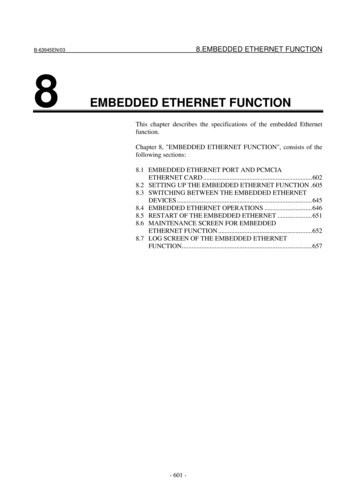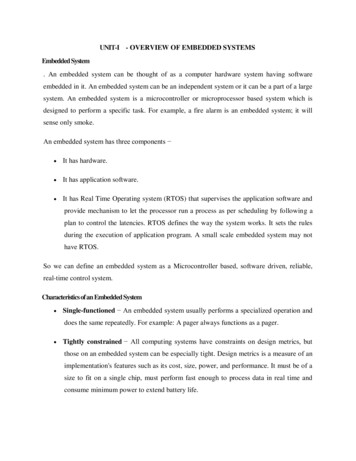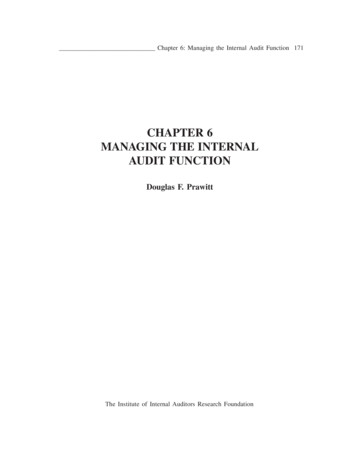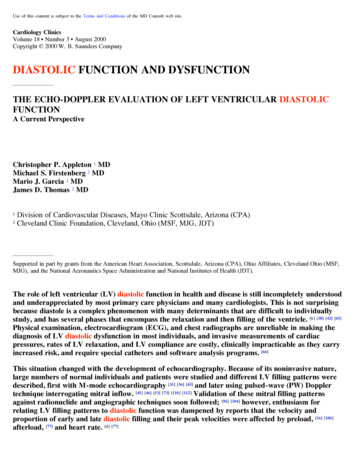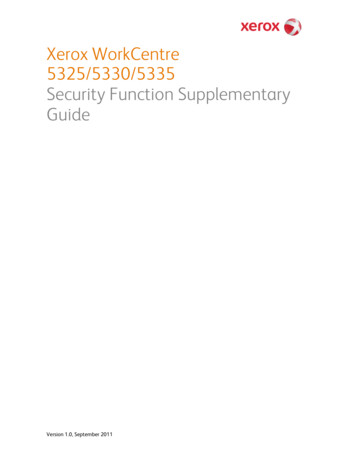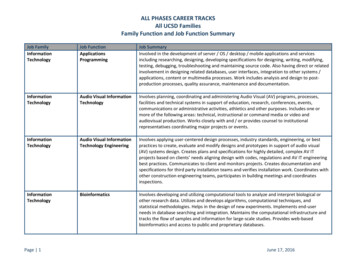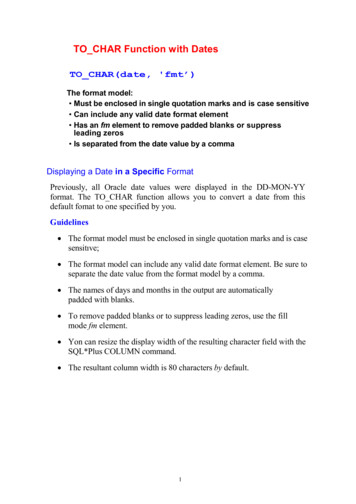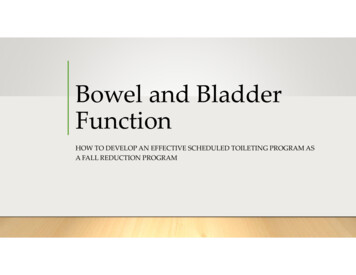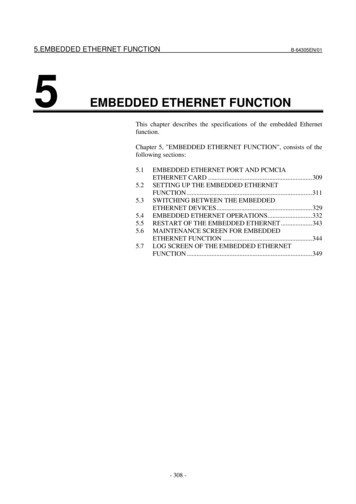
Transcription
5.EMBEDDED ETHERNET FUNCTION5B-64305EN/01EMBEDDED ETHERNET FUNCTIONThis chapter describes the specifications of the embedded Ethernetfunction.Chapter 5, "EMBEDDED ETHERNET FUNCTION", consists of thefollowing sections:5.15.25.35.45.55.65.7EMBEDDED ETHERNET PORT AND PCMCIAETHERNET CARD .309SETTING UP THE EMBEDDED ETHERNETFUNCTION .311SWITCHING BETWEEN THE EMBEDDEDETHERNET DEVICES.329EMBEDDED ETHERNET OPERATIONS.332RESTART OF THE EMBEDDED ETHERNET.343MAINTENANCE SCREEN FOR EMBEDDEDETHERNET FUNCTION .344LOG SCREEN OF THE EMBEDDED ETHERNETFUNCTION .349- 308 -
5.EMBEDDED ETHERNET FUNCTIONB-64305EN/015.1EMBEDDED ETHERNET PORT AND PCMCIA ETHERNETCARDThe embedded Ethernet function can be used by selecting one of twotypes of devices: the embedded Ethernet port and PCMCIA Ethernetcard.A selection can also be made to stop the embedded Ethernet function.The PCMCIA Ethernet card is to be inserted into the memory card slotfor temporary communication.CAUTION1 When using the embedded Ethernet function for thefirst time, set an IP address and other items carefullyas instructed by the network administrator, thenperform a sufficient communication test.Note that an incorrect IP address or other settingmay cause a communication failure on the entirenetwork.2 A unit such as a PC situated in the same networkcan increase the communication processing load onthe CNC even if the unit is not communicating withthe CNC.Avoid connecting the CNC to a factory-widenetwork. Use a router or the like to separate thenetwork including the CNC from the other networks.NOTE1 Use the PCMCIA Ethernet card designated byFANUC. General Ethernet cards available on themarket cannot be used.2 The PCMCIA Ethernet card is used for FANUCLADDER-III or SERVO GUIDE.3 Use the PCMCIA Ethernet card just for temporarycommunication as described above. Avoid usingthe card for continuous communication.4 The PCMCIA Ethernet card is inserted into amemory card slot, with a part of the card leftuninserted. When using the PCMCIA Ethernetcard, take great care not to damage the card byhitting the protruding part of the card.When the card becomes unnecessary, remove thecard immediately, in order to prevent any damageto the card.- 309 -
5.EMBEDDED ETHERNET FUNCTIONB-64305EN/01Related NC parameters#7#6#514880[Input type][Data type]#0ETH#4#3#2#1#0ETHSetting inputBitThe embedded Ethernet function (embedded Ethernet port orPCMCIA Ethernet card) is:0: Used.1: Not used.- 310 -
5.EMBEDDED ETHERNET FUNCTIONB-64305EN/015.2SETTING UP THE EMBEDDED ETHERNET FUNCTIONThis section describes the setting of parameters for the embeddedEthernet function.5.2.1Setting of the FOCAS2/Ethernet FunctionThis subsection describes the settings required to operate theFOCAS2/Ethernet function.Notes on using the FOCAS2/Ethernet function for the first timeNOTE1 When running user's original application softwarecreated by using the FOCAS2/Ethernet function, usethe embedded Ethernet port.2 The FOCAS2/Ethernet function allows up to fiveFOCAS2/Ethernet clients to be connected to oneCNC.3 Concurrent access by multiple applications orpersonal computers may overload the CNC,reducing the communication speed.- 311 -
5.EMBEDDED ETHERNET FUNCTION5.2.1.1B-64305EN/01Operation on the FOCAS2/Ethernet setting screenOn the Ethernet parameter setting screen, set the parameters foroperating the FOCAS2/Ethernet function.Procedure1Press the function key2Soft keys [EMBED] and [PCMCIA] appear.(When there is no soft keys, press the continue key.)To display the Ethernet Setting screen for the embedded Ethernetport or the PCMCIA Ethernet card, press soft key [EMBED] or[PCMCIA], respectively.Press soft keys [COMMON] and [FOCAS2] and then enterparameters for the items that appear.34.NOTE1 The parameters for the embedded Ethernet portand the parameters for the PCMCIA Ethernet cardare independent of each other.2 The settings of the FOCAS2/Ethernet function forthe PCMCIA Ethernet card are made when aconnection to SERVO GUIDE and FANUCLADDER-III is established.- 312 -
5.EMBEDDED ETHERNET FUNCTIONB-64305EN/01COMMON screen (BASIC)Press soft key [COMMON].displayed.The COMMON screen (BASIC) isCOMMON screen (BASIC)Settings itemsItemDescriptionIP ADDRESSSpecify the IP address of the embedded Ethernet.SUBNET MASKSpecify a mask address for the IP addresses of the(Example of specification format: "192.168.0.100")network.(Example of specification format: "255.255.255.0")ROUTER IPSpecify the IP address of the router.ADDRESSSpecify this item when the network contains a router.(Example of specification format: "192.168.0.253")Display itemsItemDescriptionMAC ADDRESSEmbedded Ethernet MAC addressAVAILABLEEnabled device of the embedded Ethernet.DEVICEEither the embedded Ethernet port or the PCMCIAEthernet card is displayed.- 313 -
5.EMBEDDED ETHERNET FUNCTIONB-64305EN/01FOCAS2 screenPress soft key [FOCAS2]. The FOCAS2 screen is displayed.FOCAS2 screenSetting itemsItemDescriptionPORT NUMBERSpecify a port number to be used with the(TCP)FOCAS2/Ethernet function. The valid input range is5001 to 65535.PORT NUMBERSet this item to 0 when it is used as the(UDP)FOCAS2/Ethernet function.TIME INTERVALSet this item to 0 when it is used as theFOCAS2/Ethernet function.NOTE1 When a connection to the CIMPLICITY i CELL isestablished, set the UDP port number and timeinterval above as described in the FANUCCIMPLICITY i CELL Operator's Manual (B-75074).2 The unit of the time interval is 10 ms. The allowablerange is between 10 and 65535. A time intervalless than 100ms cannot be set.3 Decreasing the time interval setting increases thecommunication load and can affect the networkperformance.Example) If the interval is set to 100 (100 x 10 ms 1 second), broadcast data is sentevery 1 second.- 314 -
5.EMBEDDED ETHERNET FUNCTIONB-64305EN/01Initial setting of the PCMCIA Ethernet cardThe PCMCIA Ethernet card is factory-set to the following defaultvalues, for ease of connection with SERVO GUIDE or FANUCLADDER-III.IP ADDRESS: 192.168.1.1SUBNET MASK: 255.255.255.0ROUTER IP ADDRESS : NonePORT NUMBER (TCP) : 8193PORT NUMBER (UDP) : 0TIME INTERVAL:0If a specified IP address is changed to a blank (space), the specifiedsetting is reset to the default value.The embedded Ethernet port does not have a default value.5.2.1.2Example of setting the FOCAS2/Ethernet functionThe following shows a setting example required for theFOCAS2/Ethernet function to operate.In this example, one personal computer is connected to two CNCsthrough FOCAS2/Ethernet.HUBCNC 1CNC 1IP addressSubnet maskRouter IP addressTCP port numberUDP port numberTime intervalCNC 210BASE-T or100BASE-TXPC 1CNC 2192.168.0.100 192.168.0.101255.255.255.0 255.255.255.0NoneNone819381930000The Ethernet parameter screen is used forsetting.PC 1IP addressSubnet maskDefault gatewayCNC 1NC IP addressNC TCP port numberCNC 2NC IP addressNC TCP port number"Microsoft TCP/IP property" of the personalcomputer (Windows 2000/XP/Vista) is usedfor 08193192.168.0.1018193The arguments of the data window libraryfunction cnc allclibhndl3 are used forsetting.- 315 -
5.EMBEDDED ETHERNET FUNCTION5.2.2B-64305EN/01Setting of the FTP File Transfer FunctionThis section describes the settings required for the FTP file transferfunction to operate using the embedded Ethernet function.Notes on using the FTP file transfer function for the first timeNOTE1 When using the FTP file transfer function, use theembedded Ethernet port.2 The number of FTP communications to which oneCNC can be connected using the FTP file transferfunction is one.5.2.2.1Operation on the FTP file transfer setting screenOn the Ethernet setting screen, set the parameters for operating theFTP file transfer function.Procedure1Press the function key2Soft keys [EMBED] appear.(When there is no soft keys, press the continue key.)By pressing the [EMBED] soft key, the Ethernet Setting screenfor the embedded Ethernet port is displayed.Press soft keys [COMMON] and [FTPTRNS] and then enterparameters for the items that appear.34.NOTEThe parameters for the embedded Ethernet portand the parameters for the PCMCIA Ethernet cardare independent of each other.If the [PCMCIA] soft key is pressed, the PCMCIAEthernet card can be set up. However, the cardsetup is carried out for maintenance and is notnecessary usually.- 316 -
5.EMBEDDED ETHERNET FUNCTIONB-64305EN/01COMMON screen (BASIC)Press soft key [COMMON].displayed.The COMMON screen (BASIC) isCOMMON screen (BASIC)Setting itemsItemDescriptionIP ADDRESSSpecify the IP address of the embedded Ethernet.SUBNET MASKSpecify a mask address for the IP addresses of the(Example of specification format: "192.168.0.100")network.(Example of specification format: "255.255.255.0")ROUTER IPSpecify the IP address of the router.ADDRESSSpecify this item when the network contains a router.(Example of specification format: "192.168.0.253")Display itemsItemDescriptionMAC ADDRESSEmbedded Ethernet MAC addressAVAILABLEEnabled device of the embedded Ethernet.DEVICEEither the embedded Ethernet port or the PCMCIAEthernet card is displayed.- 317 -
5.EMBEDDED ETHERNET FUNCTIONB-64305EN/01FTP transfer screen (CONNECT1, CONNECT2, CONNECT3)1Press soft key [FTPTRNS].displayed.2Page keysThe FTP transfer screen iscan be used to make settings for the threehost computers for connection destinations 1 to 3.FTP transfer screen (1st page)FTP transfer screen (2nd page)ItemDescriptionHOST NAME- 318 -Specify the IP address of the host computer.(Example of specification format: "192.168.0.200")
5.EMBEDDED ETHERNET FUNCTIONB-64305EN/01ItemDescriptionPORT NUMBERSpecify a port number to be used with the FTP filetransfer function. An FTP session is used, so that "21"is to be specified usually.USERNAMESpecify a user name to be used for logging in to thehost computer with FTP.(Up to 31 characters can be specified.)PASSWORDSpecify a password for the user name specified above.(Up to 31 characters can be specified.)Be sure to set a password.LOGIN FOLDERSpecify a work folder to be used when logging in to thehost computer. (Up to 127 characters can bespecified.)If nothing is specified, the home folder specified in thehost computer becomes the log-in folder.OperationSelect a destination.1Pressing the [(OPRT)] soft key causes soft key [HOST] to bedisplayed. Pressing this soft key causes soft keys [CONECT 1],[CONECT 2], and [CONECT 3] to be displayed.2Depending on the host computer to be connected, press soft key[CONECT 1], [CONECT 2], or [CONECT 3]. Destination 1, 2,or 3 is highlighted in the screen title field. The computercorresponding to the highlighted destination is selected as thetarget computer to be connected.When destination 1 is selected- 319 -
5.EMBEDDED ETHERNET FUNCTION5.2.2.2B-64305EN/01Related NC parametersThe NC parameters related to the FTP file transfer function aredescribed below.I/O CHANNEL : Input/output device selection, or interface number for aforeground input device0020[Input type][Data type][Valid data range]Setting inputByte9 : Select the embedded Ethernet as the input/output device.#7#613115[Input type][Data type]#5#4SI2SI1#3#2#1#0Parameter inputBit#4SI1Soft key input of the characters shown below is:0: Disabled.1: Enabled. % ! :"'#5SI2Soft key input of the characters shown below and switching betweenthe uppercase and lowercase input modes by a soft key are:0: Disabled.1: Enabled.()?*&@For embedded Ethernet port#7#6#514880[Input type][Data type]#1PCH#4#3#2#1#0PCHSetting inputBitWhen communication based on the FTP file transfer function starts, anFTP server presence check based on PING is:0: Made1: Not madeNOTEGenerally, set this parameter to 0 so that an FTPserver presence check based on PING is performed.Otherwise, if the server is not present in the network,it takes several tens of seconds to detect an error.Some PCs are set not to response to the PINGcommand mainly for security purposes. Tocommunicate with such a PC, set this parameter to1.- 320 -
5.EMBEDDED ETHERNET FUNCTIONB-64305EN/0114890Selects the host computer 1 OS.14891Selects the host computer 2 OS.14892Selects the host computer 3 OS.[Input type][Data type][Valid data range]Parameter inputWord0 to 20: Windows2000/XP/Vista.1: UNIX, VMS.2: Linux.NOTESome FTP server software products do not dependon the OS. So, even when the above parametersare set, it is sometimes impossible to display a listof files properly.- 321 -
5.EMBEDDED ETHERNET FUNCTION5.2.2.3B-64305EN/01Example of setting the FTP file transfer functionThe following shows a setting example required for the FTP filetransfer function to operate.In this example, one personal computer is connected to two CNCsthrough the FTP file transfer function. On Personal Computer 1, the FTP server function operates. On CNC 1 and CNC 2, the FTP client operates as the FTP filetransfer function.HUBCNC 1CNC 1IP addressSubnet maskRouter IP addressConnectionPort numberhost 1IP addressUser namePasswordLogin DIRNC parameter No. 20PC 1CNC 2192.168.0.100 192.168.0.101255.255.255.0 255.255.255.0NoneNone2121192.168.0.200 192.168.0.200useruseruseruserNoneNone99PC 1IP addressSubnet maskDefault gatewayUser namePasswordLogin DIRCNC 210BASE-T or100BASE-TXThe Ethernet parameter screen is used forsetting.The parameter screen is used for setting."Microsoft TCP/IP property" of the personal computer(Windows 2000 / XP / Vista) is used for ult"User acount of the personal computer (Windows 2000/ XP / Vista) is used for setting."Internet service manager" of the personal computer(Windows 2000 / XP) is used for setting."FTP Publ
2 The PCMCIA Ethernet card is used for FANUC LADDER-III or SERVO GUIDE. 3 Use the PCMCIA Ethernet card just for temporary communication as described above. Avoid using the card for continuous communication. 4 The PCMCIA Ethernet card is inserted into a memory card slot, with a part of the card left uninserted. When using the PCMCIA Ethernet card, take great care not to damage the card by .
